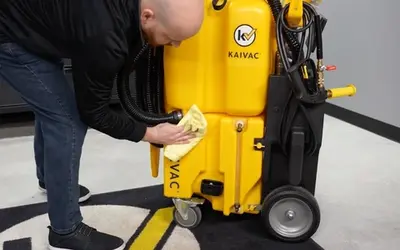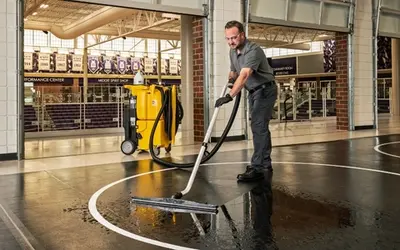Help Wanted: Tips to Improve Cleaning Worker Retention

Labor shortages were labeled the “Number One problem facing American business,” by chief executive of the U.S. Chamber of Commerce Suzanne Clark. Obviously, hiring and holding on to employees challenges every sector, but the maintenance industry faces a particularly hard problem with cleaning worker retention.
Cleaning company turnover rates always ran high, around 300% according to most estimates. This number means companies must fill one custodial position three times a year. The practice is more than just an HR headache. It also diverts a tremendous amount of money, time, and effort into recruiting and training new hires – and away from everything else.
On the other hand, smart companies can address cleaning labor shortages and stop the endless turnover machine, even in a tight job market. It starts by empowering employees with tools and training that keeps them safe, successful, and happy at work. And happy employees, secure in their position as valued team members, rarely seek work elsewhere.
Not sure how to empower employees? Here are some simple tips and tools to make their work rewarding and improve cleaning worker retention.
Improve Worker Safety
A poor safety climate was a top concern reported by Washington State janitorial workers, according to a report from the state’s Department of Labor and Industries. That is no surprise. Janitorial work is dangerous, and the hazards come from all directions.
Workers handle potentially harmful cleaning chemicals. They regularly come into contact with pathogens and bodily fluids. They suffer from higher rates of asthma due to chemical use. Risks for slip, trip, and fall incidents meet them with almost every task.
But the biggest safety threat to cleaning personnel are musculoskeletal disorders, in other words, ergonomic injuries. These injuries usually come about slowly as the worker completes the same strenuous tasks over and over. The Occupational Safety and Health Administration (OSHA) identified several risk factors for these kinds of injuries including.
Injury Risk Factors
- Exerting excessive force
- Performing the same task repetitively
- Working in an awkward position
- Localized pressure on one body part
- Combined exposure to several risk factors
Addressing these risks early limits severity, improves treatment outcomes, and furthermore, minimizes the chance of permanent damage. But don’t wait for staff to come to you to complain about aches and pains. A University of Minnesota Twin Cities study found that janitors don’t report injuries for many reasons, but the most alarming one is because of an “understanding that injuries are part of the job.”
Make it clear to employees that injuries are, in fact, not part of the job. Check in with them about their physical state. Observe if they are wearing back belts or wrist braces or modifying equipment; a sure sign that something is wrong. Talk about ergonomics and how proper positioning protects the body. By improving job safety and comfort, employers and managers will also improve cleaning worker retention.
No-Touch Cleaning for Restrooms
Speaking of the unpleasant aspects of cleaning work, no one likes cleaning restrooms, and for good reason. Most restroom cleaning methods ask workers to bend, reach, crawl around, and touch unpleasantly dirty surfaces. No wonder it is everyone’s most hated task.
Companies can improve restroom cleaning by investing in a No-Touch Cleaning® systems. Because the worker operates the system in a neutral, upright position, No-Touch Cleaning removes the need to bend, crawl, twist, scrub, and wipe, effectively eliminating a lot of injury risk factors. As they are no-touch, the machines also limit the possibility of encountering dangerous pathogens, another form of on-the-job risk.
No-Touch Cleaning systems also work faster than traditional methods like scrubbing, mopping, and wiping while delivering better results. A lightened workload coupled with a sparkling-clean space makes workers feel accomplished, empowered, and ready to tackle the next task.
Invest in Training
Training is a multi-layered investment – a critical investment for improving cleaning worker retention. Yes, it lays out expectations about a task and offers procedures and protocols to meet those expectations. But training does much more. It also telegraphs that an employee has value, that they are worth the resource, and that they have a future with the organization.
But training takes time and money, and there is always the risk that employees will revert to their old ways. To cut expenses while keeping training front and center, many companies are moving to digital learning tools.
KaiTutor Onboard Training
Consider empowering employees with a tool like the KaiTutor™. KaiTutor works like a personal trainer that never leaves the employee’s side. A tablet is mounted directly on the cleaning machine. The technology displays instructional videos that demonstrate exactly how to use the equipment to clean to a high standard.
This visual instruction breaks down language barriers, allowing universal access to learning. Users can play, pause, and practice the skill as needed, enhancing confidence and mastery. The result? Empowered employees, correctly cleaned spaces, and happy clients.
Cleaning workers show up every day to protect the public with healthy spaces. Employers who give them safety on the job, quality equipment, and ongoing training will earn employee loyalty and improve cleaning worker retention. Learn more about how to elevate, empower, and protect cleaning workers here.
Related Posts

Preventive Maintenance for Your No-Touch Cleaning® System
Your Kaivac No-Touch Cleaning system makes restroom maintenance fast and easy. Keeping your No-Touch Cleaning system in good working order is also fast and easy. Kaivac makes performing preventative maintenance and troubleshooting potential issues simple. No special equipment or technical expertise required.
Read more
A Cleaning Lesson from Schools and Universities that Rely on Kaivac Systems
School, college, and university facilities departments from around the country love their Kaivac Cleaning Systems. Why wouldn’t they? Designed with the custodial worker in mind, these tools and processes from Kaivac are easy to master, work super-fast, and deliver exceptionally clean, fresh-smelling spaces.
Read more
Reduce Absenteeism Through Better School Cleaning
K-12 school leaders are coming up with a variety of ways to combat chronic absenteeism. Strategies like offering in-school laundry services and basic health care show a lot of promise. But providing better cleaning may be one of the most effective, most cost-efficient tactics available.
Read more